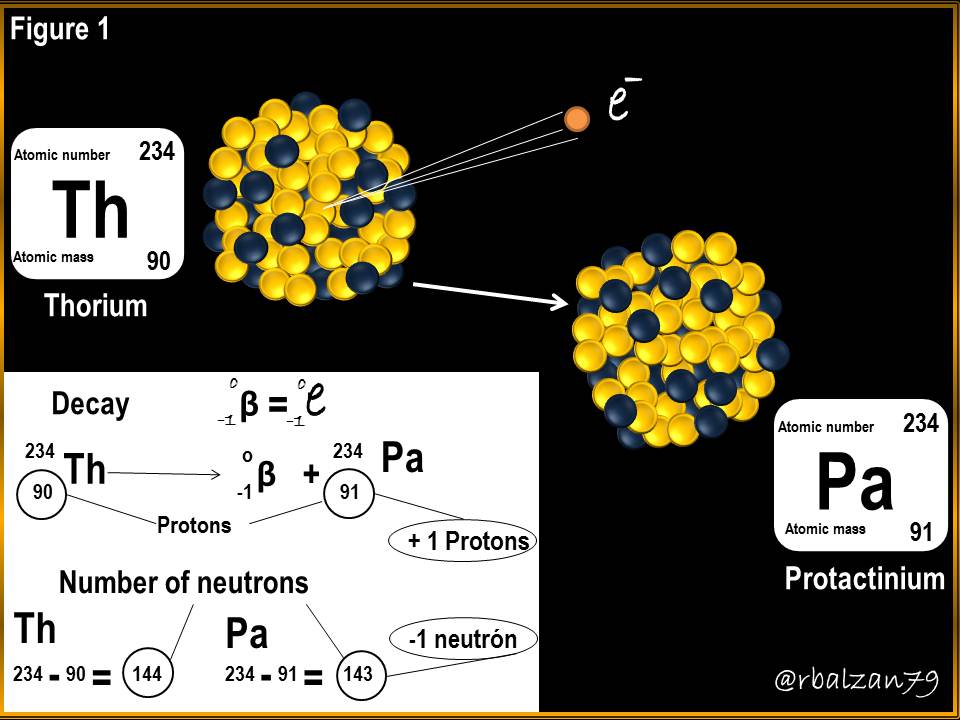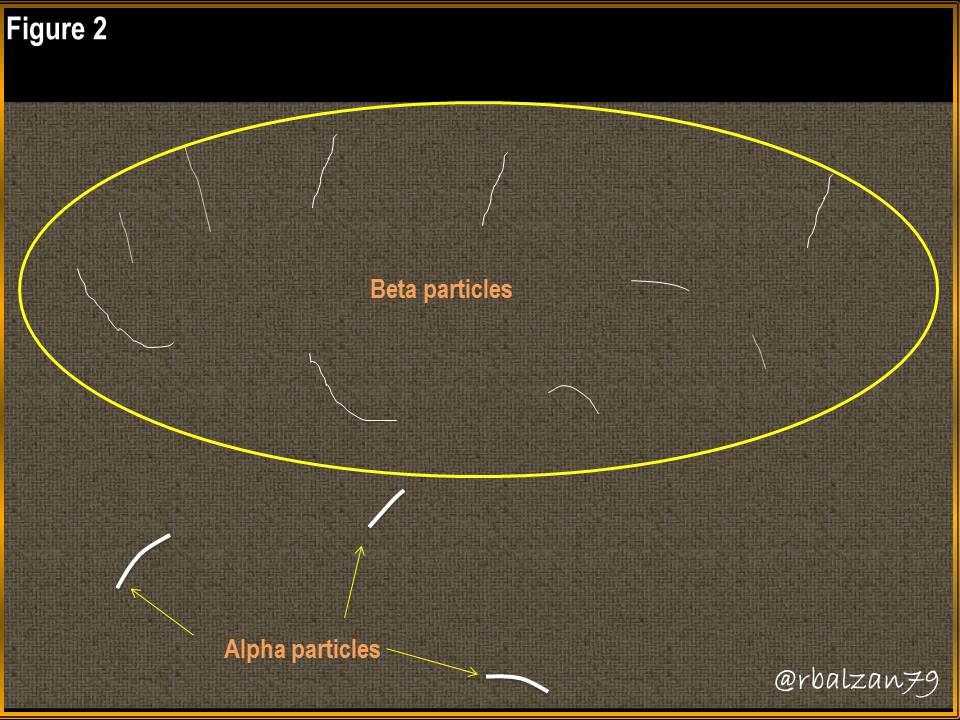Beta rays (β)

Introduction
We continue with our essential search for any type of radiation present among us, and that generally these radiations are imperceptible to our natural optical systems (eyes), but nevertheless, the above feature has not limited us in terms of obtaining any learning about them, and through the implementation of science we have been able to implement them in our daily activities, and even more important to take care of these radiations especially when dealing with radiation with ionization capacity as we have noticed both with X-rays, gamma and alpha.
Therefore, on this occasion we will analyze beta (β) rays in a general way, and the same as alpha rays are not electromagnetic in nature but belong to the family of corpuscular radiations, always bearing in mind, my dear readers, that a radiation is a manifestation of energy which propagates from a certain space-time to another, as we could observe with electromagnetic radiations and alpha (α) rays.
Let us remember that electromagnetic radiations do not have any kind of mass, and therefore, they only contain energy, but when talking about corpuscular radiations it is necessary to emphasize that such radiations propagate with the presence of mass quantity as we visualized with alpha (α) rays in our previous installment.
As in the other articles related to electromagnetic radiation and corpuscular radiation (alpha rays), we will be using the essential conceptualization of rays with straight-line propagation, with the above conceptualization and all the learning that we have developed so far we will be guided in the study of this topic related to beta (β) rays.
Therefore, it is necessary to begin by stating that beta (β) rays are part of the family of ionizing corpuscular radiation, and just as we did with alpha (α) rays, this time we will relate beta (β) rays to electromagnetic radiation, among which are X-rays and gamma rays, and we will see their penetrability capabilities, where we will also include alpha (α) rays.
The above analysis will allow us to know the degree of danger of the aforementioned radiations to our bodies due to the fact that they have the capacity to ionize the material with which they come into contact. In the previous section we were able to verify how alpha (α) rays, due to their mass charge, have a greater ionization capacity than X and gamma rays; however, their penetrability capacity compared to the electromagnetic radiations mentioned above is reduced.
Beta (β) rays
When we identify ourselves with corpuscular radiations, we will observe that such radiations will propagate in certain sub-atomic particles and the same with a certain amount of mass, as we verified in the alpha rays (α) or the helium nucleus, they also propagate in electrons or beta particles (β), where it is necessary to highlight that the speed of such particles will always be lower than the manifestations of energy represented by electromagnetic radiations.
Atomic nuclei are structured by vital particles known as neutrons and protons, the set of these particles are also identified as nucleons, and when focusing from the chemical point of view, protons are those that differentiate the different elements present in our periodic table.
And of the neutrons we can say that they can be present in various quantities and still be the same type of element, therefore, when the same element has the same amount of protons but different amounts of neutrons, then we would be in the presence of the so-called isotopes of the element analyzed.
This leads us to express that isotopes are atoms of the same chemical element, but their nucleus has a different number of neutrons, therefore, we can find stable isotopes, and this is because their nucleus does not vary over time, however, we also find unstable or radioactive isotopes, since their nucleus varies over time, this allows rays or radiation such as alpha (α) and beta (β) to originate.
Therefore, beta rays or particles are electrons and positrons emitted at a high speed (less than the speed of light) by a given atomic nucleus and this through a radioactive process, then, this leads us to express that such beta rays (β) can be emitted in two different ways, one of them is called negative beta ray emission, and the other is called positive beta.
As for the emission of negative beta rays, it originates when a certain nucleus emits a beta particle, where a certain neutron is transformed into a proton, and we note that the nucleus will lose a component of negative charge, this causes the atomic number to increase by one unit, then, the element is transformed into a different one with the same atomic mass, then we will visualize an example of this type of generation of rays or beta particles in the following figure 1.
Figure 1. Emission of a type of beta ray (decay) by the element thorium
In the previous figure 1, we were able to observe a radioactive isotope element releasing a form of negative beta radiation, this action is called decay, as you can see, this process can also be observed in the emission of alpha rays (α), both radiations (α and β) belonging to the family of corpuscular radiation.
When referring to the generation of positive beta particles (β), in this process a proton belonging to a certain atomic nucleus becomes a neutron, and thus will emit a positron, this causes the nucleus to lose a respective positive charge, so its atomic number will decrease by one unit, so we have a new element of the same atomic mass, and whose element will be in a previous position in the periodic table to the initial element, unlike the emission of negative beta particles.
If we could visualize the trajectory of certain beta (β) particles in an instrument called a fog chamber, we would notice the difference with the behavior of the trajectory of the alpha (α) particles, this is because the path drawn by the beta (β) particles is thinner or finer than those originated by that of the rays or alpha (α) particles, and all this is because the beta (β) particles have less mass than those possessed by the alpha (α) particles.
According to the above, we can say that these beta (β) particles could be slowed down more easily in the air, thus generating irregular trajectories compared to those of alpha (α) particles, this relationship is shown in figure 2 below.
Figure 2. Fog camera detecting the path or presence of ionizing radiation, including beta particles
In the previous figure we can see the difference between the trajectories between beta particles (β) and alpha particles (α), with one trajectory being finer or thinner (beta) than the others (alpha).
The above relationship leads us to express that beta (β) particles, having less mass than alpha (α) rays, have less energy and less ionization capacity. However, when we relate to the penetrability capacity of both, we find that beta (β) particles have a greater penetrability capacity, but less than those of X and gamma rays, as shown in Figure 3 below.
Figure 3. Penetrability of beta rays relative to alpha, X-rays and gamma rays
In the previous figure 3, we could easily observe the penetrability capacity of the aforementioned radiations, where we have two of electromagnetic nature (X and gamma rays) and two corpuscular (alpha and beta).
After relating the previous radiations and their penetrability, it is important to emphasize that although these radiations are imperceptible to our natural optical systems (eyes), we have not been limited in their use in any of our activities and even towards us, such is the case of the medical activity known as Brachytherapy, which represents a technique of internal radiotherapy, as we can see in the following figure 4.
Figure 4. Brachytherapy applied in some part of our body such as the prostate
What stands out is that in spite of its capacity to generate damage to our organism, we have been able to reverse this action in some cases as shown in figure 4 above, and its implementation for the treatment of some types of cancer.
We can mention other applications that man has been able to positively give to this type of ionizing radiation, such as beta particles (β) or beta radiation (β).
Figure 5. Application of beta (β) rays in old clocks to achieve a fluorescence effect
In the previous figure 5, we can visualize the extinct use of this method, which was implemented with the purpose of originating a fluorescence effect in the numbers and hands of old watches, creating an impression in the people who acquired such garments, for this purpose elements such as tritium were used, which is a beta (β) ray emitting agent.
Conclusion
So far we have been able to prove that radiations are present in any space-time of our existence, either electromagnetic or corpuscular in nature and whose emission can originate both artificially and naturally, if our natural optical systems (eyes) had the ability to observe all these radiations we would see their action at all times around us.
In this installment we continue with the deepening of learning related to corpuscular radiation, and the same as expressed represent a type of energy propagation, and also is linked to a certain amount of mass, as we specified in alpha rays (α) and now with beta rays (β).
We were also able to demonstrate that the knowledge generated from electromagnetic radiations (especially from white or visible light) has always represented the fundamental basis for the extension of any kind of knowledge related to any other form of energy manifestation such as corpuscular radiations.
According to the above, we could affirm that it would be impossible to talk about the evolution of man without mentioning all that learning linked to the different radiations that originate in our universe, and this we have been presenting and also demonstrating with the development of each of the previous articles, especially those where we link with the different rays or radiations both electromagnetic and corpuscular.
We learned in a general way some of the applications in our lives of the particles or rays (β), in spite of their ionization capacity and penetrability, aspect that we were able to compare with other electromagnetic radiations such as X and gamma rays and also corpuscular such as alpha particles (α).
Undoubtedly, we can say that most of the radiations that surround us are invisible or imperceptible to our eyes, but nevertheless, man, thanks to his powerful investigative-experimental tool such as science, has achieved essential advances which he has implemented in the area of technology and design extraordinary machines, tools or devices for the benefit of all mankind.
Until another delivery my appreciated readers of Hive.blog, specially to the members of the great community of #Stemsocial, which receives the support of another wonderful community like #curie, reason why I recommend widely to be part of this exemplary project, since they allow us to emphasize the wonderful task of the academy and the enormous work of all the field of science.
Note: The images are my own, made in Power Point, the animated gif was made with the PhotoScape application.
Bibliographic References
[1]Charles H. Lehmann. Analytical geometry
[2]FUNDAMENTAL RADIATION CONCEPTS
[3]Los fenómenos radiactivos y el descubrimiento del núcleo atómico





Thanks for your contribution to the STEMsocial community. Feel free to join us on discord to get to know the rest of us!
Please consider supporting our funding proposal, approving our witness (@stem.witness) or delegating to the @stemsocial account (for some ROI).
Please consider using the STEMsocial app app and including @stemsocial as a beneficiary to get a stronger support.
Thank you community for your valuable support. Best regards.